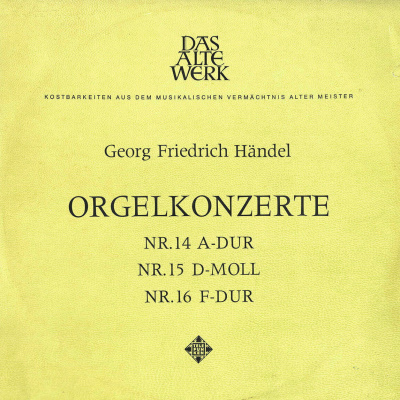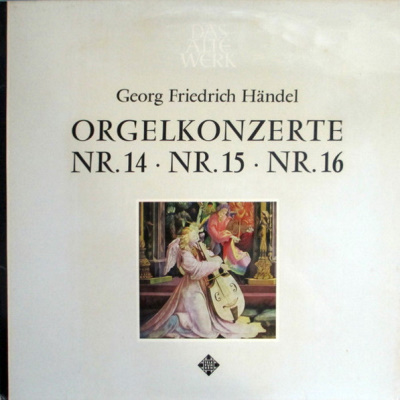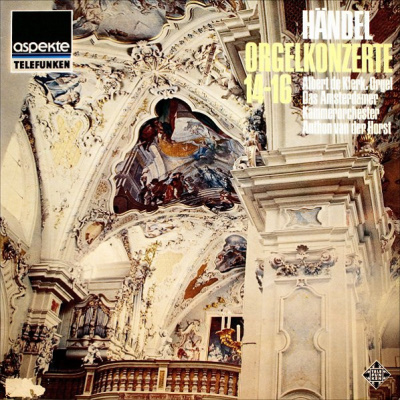 |
|
1 LP -
SAWT 9441-B - (p) 1963
|
 |
| 1 LP -
SAWT 9441-B - (p) 1963 |
 |
| 1 LP -
6.41327 AH - (p) 1975 |
|
| ORGELKONZERTE |
|
|
|
|
|
|
|
| Georg Friedrich
HÄNDEL (1685-1759) |
Orgelkonzert
Nr. 14 A-dur |
|
18' 10" |
A1 |
|
- (1.
Largo e staccato · 2. Andante · 3. Grave ·
4. Allegro)
|
|
|
|
|
Orgelkonzert Nr. 15 d-moll |
|
11' 55" |
|
|
- (1.
Andante · |
5' 40" |
|
A2 |
|
- 2.
[Largo] · 3. Allegro) |
6' 15" |
|
B1 |
|
Orgelkonzert
Nr. 16 F-dur |
|
18' 05" |
B2 |
|
- (1.
Ouverture · 2. Allegro · 3. Allegro ma non
troppo · 4. Adagio · 5. Andante · 6.
Allegro · 7. Marche) |
|
|
|
|
|
|
|
|
Albert DE KLERK,
an der Flentrop-Orgel in der Kirche zu
Loenen an der Vecht
AMSTERDAMER KAMMERORCHESTER
Gustav Leonhardt, Cembalo
Anthon van der HORST, Dirigent
|
|
|
|
|
|
Luogo
e data di registrazione |
|
(luogo di
registrazione non indicato) - 1963
|
|
|
Registrazione: live
/ studio |
|
studio |
|
|
Producer |
|
-
|
|
|
Prima Edizione LP |
|
Telefunken "Das Alte
Werk" | SAWT 9441-B (Stereo) - AWT
9441-C (Mono) | 1 LP - durata 48'
10" | (p) 1963 | ANA
Telefunken "Das Alte Werk" | SAWT
9441-B | 1 LP durata 48' 10" | (p)
1963 | ANA | Riedizione
Telefunken
"Aspkte" | 6.41327 AH | 1 LP
durata 48' 10" | (p) 1975 | ANA
| Riedizione |
|
|
Edizione CD |
|
Non si è a
conoscenza di una
ripubblicazione in Compact
Disc |
|
|
Cover
|
|
- |
|
|
Note |
|
-
|
|
|
|
|
Handel's organ
playing in the highly
popular performances of his
many organ concertos
inspired eulogies in verse
from several of his
contemporaries. Another of
them, the musical historian
Sir John Hawkins, relates
that “Silence, the truest
applause, succeeded, the
instant that he addressed
himself to the instrument;
and that was so profound,
hat it checked respiration,
and seemed to control the
functions of nature.“ On
hearing these organ
concertos, we can well
imagine that it was not
merely a virtuoso technique
of organ playing but above
all the positive power of
expression and depth of
feeling of these works that
will have been so
fascinating in their effect.
The style of Handel's organ
concertos bears no relation
to what was otherwise the
most general use of the
organ, namely the solemn
music of the church. Handel
included these works as
intermezzi in the
performances of his
oratorios, thus delighting
the audience with a
pulsating abundance of
contrasting ideas that form
themselves in the individual
movements into delightful
song and dance melodies,
into capriccios or into the
delicate strains of higher
spheres. The thematic
material of the organ
concertos is simple, and
through frequent repetition
it becomes forceful and
familiar. The organ takes
its place alongside the
orchestra as a partner
rather than as a rival. It
is discreetly accompanied by
the orchestra, or the latter
repeats the organ's melodic
thoughts in the form of an
echo, or plays loudly and
affirmatively in the form of
a ritornello as was usual in
the concerto grosso. The
organ always steps into the
forefront with two
characteristic types of
writing, the one moving in
solemn chordal strides and
the other in filigree
agility with a silvery tone
in the high register.
In the slow movements Handel
oiten gives the organist an
opportunity of showing his
art of improvisation, an art
that he himself applied with
inexhaustible imagination on
such occasions, so that his
audiences waited eagerly for
this moment in every
performance.
The Organ Concerto in A
major (dating from
1739/40) begins with a Largo
overture that uses the
dotted rhythm of the French
overture. The orchestra
begins the movement with a
theme in this sharply
accenuated rhythm; the organ
replies with a calm melody
and each tone-producing
element ends its phrase with
a common theme in
accelerated repetition of
notes. This magical
compression of he music
imparts a mysterious quality
to the overture, which puts
the listener into a mood of
anticipation, this being
enhanced by a short cadenza
for solo violin which leads
from A major up to the
dominant key of E major and
ends in this state of
tension. The Andante
consists of a melodic period
of eight bars played by the
orchestra with episodes from
the organ in triplets and
runs. The Grave is one of
the improvisations mentioned
above, for the organ alone
over a set bass. In the
Allegro the altogether
optimistic and light-hearted
mood of the entire organ
concerto brings the work to
a carefree end with playful
alternations of organ and
orchestra.
The Concerto in D minor
begins without an overture,
taking us straight into an
Andante of meditative,
earnest character. Brighter
passages from the solo organ
are soon suppressed again by
the orchestra in the tension
of syncopations. Again in
this concerto the slow
movement is left to the
improvisation of the
organist. The Allegro in 9/8
time has a driving, hasting,
dynamic character. In spite
of its virtuoso agility, the
organ part is full of
restrained seriousness and
strict in its part-writing.
The orchestra interrupts the
organ solo in the style of a
ritornello with consistent
energy and colourfulness of
tone. The austerity and
conciseness of this organ
concerto would suggest that
it is a late work; it was
not discovered and published
until 1797.
The same is true of the Organ
Concerto in F major,
which likewise did not
appear in print until 1797.
This work sounds like a
piece of festive music. The
organ is given less
prominence, and instead
horns and oboes are added to
the orchestra. Organ and
orchestra begin the Largo
overture together, moving
along in grave strides. In
the second movement, the
fresh, cheerful rhythm and
the sound of the horns
recalls a piece of hunting
music - a la caccia - the
organ remaining in the
background until shortly
before the end of the
movement, when it leads the
music as a soloinstrument up
into the dominant key of C
major. After this, in the
third movement, it joins
with the horns and the oboes
in a colourful orchestral
texture. This colourfulness
of tone is intensified even
more in the Adagio, where
the orchestra, supported by
the harpsichord and without
wind and organ, touches the
feelings with great power of
expression. In the Andante
organ, horns, oboes and
orchestra are again united
in a play of alternations.
The Allegro in 12/8 time
again has the vivacity of a
‘caccia’; organ and
orchestra play in gay
spirits and the ensuing
March, suggesting a festive
procession, raises our
spirits still further to the
realm of vigorous yet deeply
religious optimism. Handel
has taken this march from
his oratorio “Judas
Maccabaeus.“
Otto
v. Irmer
|
  |
|
|